Luffa is the genus name of several tropical and subtropical plants in the cucumber family (Cucurbitaceae) (Stephens 2015). Alternatively, spelled "loofa" or "loofah," the name is derived from the plant's use as a material for sponges and dish cloths for bathing and cleaning dishware (Oboh and Aluyor 2009). The name "Luffa" was introduced to Western botany nomenclature by the German anatomist and botanist, Johann Veslingius (1598–1649). A French botanist, Joseph Pitton de Tournefort (1656–1708), introduced the formal botany genus name "Luffa." The species is native to tropical Asia but has also been grown in Egypt since the late medieval era. While is widely cultivated in Asia, particularly in China and Vietnam, the gourd has recently become an attractive commodity on US vegetable markets, including Asian groceries in New York, California, Florida and other states.
Description
There are two common species in the Luffa genus: smooth luffa (Luffa aegyptiaca Mill.), also called sponge gourd, and angled luffa (Luffa acutangula (L.) Roxb.). In the 16th century, Vestingius named luffa "Egyptian cucumber." Common English terms for angled luffa include Chinese okra, dish cloth gourd, ribbed loofah, ridged gourd, sponge gourd, silky gourd, sinkwa towelsponge (USDA 2016), strainer vine, and vegetable gourd. Fresh produce of both smooth and angled luffa varieties is emerging on Florida vegetable markets. Smooth luffa, as its name suggests, produces green, squash-like fruit (Figure 1). Common cultivars for smooth luffa include 'Smooth Boy', 'Smooth Beauty', and 'South Winner'. For angled luffa, the fruit slightly resembles a cucumber or zucchini with 8 to 10 longitudinal ridges and ribs and a dark green color (Figure 2). Prominent cultivars include 'Lucky Boy', 'Hybrid Green Glory', 'Summer Long', and 'Hybrid Asian Pride'.

Credit: Guodong Liu, UF/IFAS (Left); Cuiping Huang, Hubei, China (Right)

Credit: Guodong Liu, UF/IFAS
Luffa is a fast-growing, long-season, and warm-climate crop that prefers neutral to slightly alkaline soil conditions with high moisture, growing annually in tropical and subtropical conditions. The stem is glabrous and ribbed and can grow up to 23 feet. Tendrils have 3 to 5 branches with stems 2 to 3 inches in length and branches 3 to 4 inches in length (Figure 3). A trellis is needed for optimum fruit production and to cultivate straighter fruits (Zong et al. 1993).
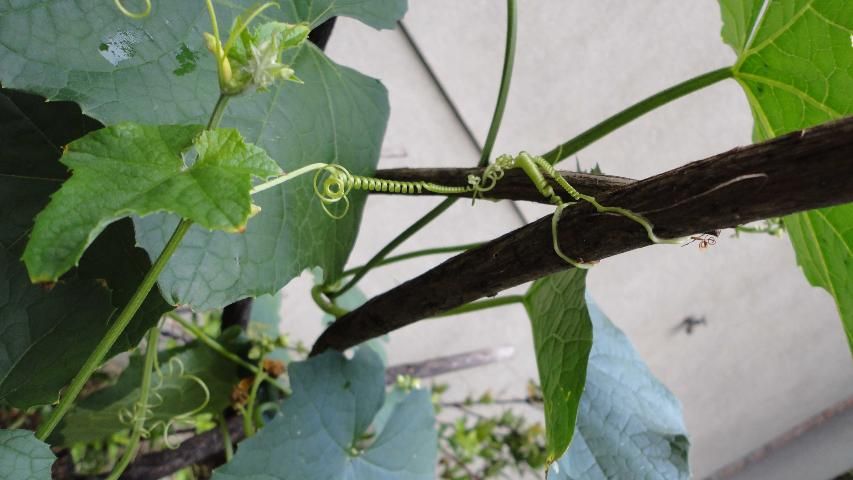
Credit: Guodong Liu, UF/IFAS
Cultivation Method
Mature luffa seeds are typically dark and hard, resembling watermelon seeds in size and shape. Immature seeds typically have a lighter color and are softer than mature ones (Figure 4).
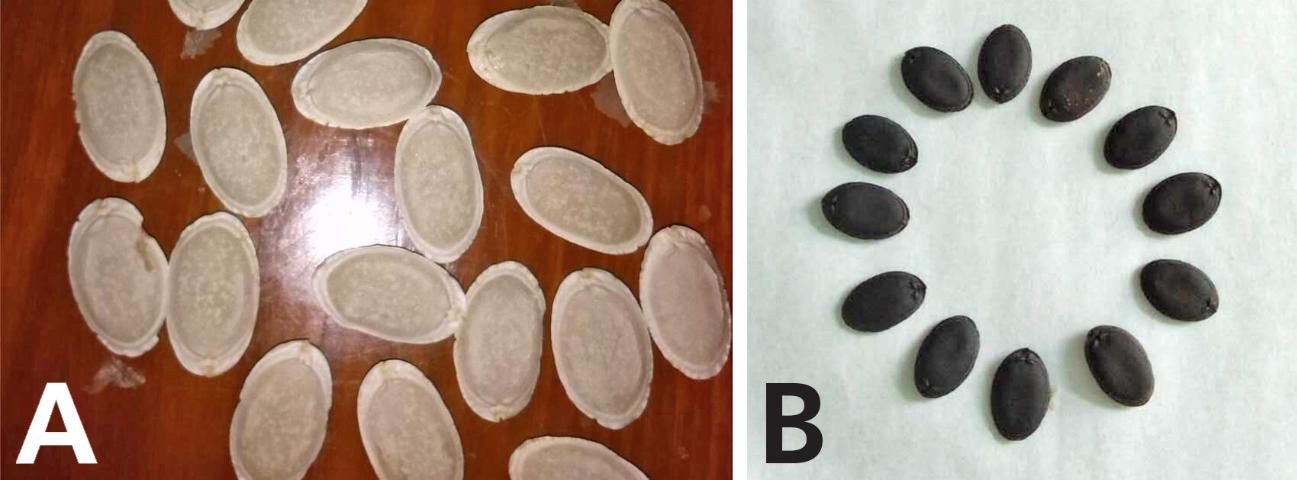
Credit: Cuiping Huang, Hubei, China
The leaves of luffa are alternating (Figures 5 and 7) and palmate-like, a pattern which is like squash and gourd plant foliage, or other species belonging to the cucumber family. A fully developed leaf is typically up to 12 inches wide and 5 inches long and has an acute-end lobe, serrated edges, and is hairless (Figure 5).

Credit: Cuiping Huang, Hubei, China
Direct seeding (Figure 6) and transplanting are both used for growing luffa in Florida. Seedlings can be transplanted once they have two or three true leaves (Figure 7). Direct seeding is fast and can save labor, but it cannot be used before the frost-free season ends. Transplanting requires that the seedlings be ready and is more labor-consuming, but this method can expand the growing season and provide an earlier harvest with higher market value. The growth habit of luffa is like that of cucumber (Cucmis stivaus L.), except that Luffa must have well drained soil and requires high moisture conditions. Excessive water is detrimental, potentially slowing growth and increasing the risk of root disease. In addition, damping off may threaten young seedlings grown in cold and wet areas. For planting or transplanting, the distance between plants is usually 3 feet, and the distance between rows is 6 feet. Vine length is up to 30 feet. Vertical trellises (Figure 11) of 6 feet in height are recommended because they substantially increase fruit yield (Davis 1994). A mature luffa plant can bear about 6–7 fruit in ideal growing conditions. Luffa can also be grown in 2- to 5-gallon containers (Figure 7).

Credit: Guodong Liu, UF/IFAS
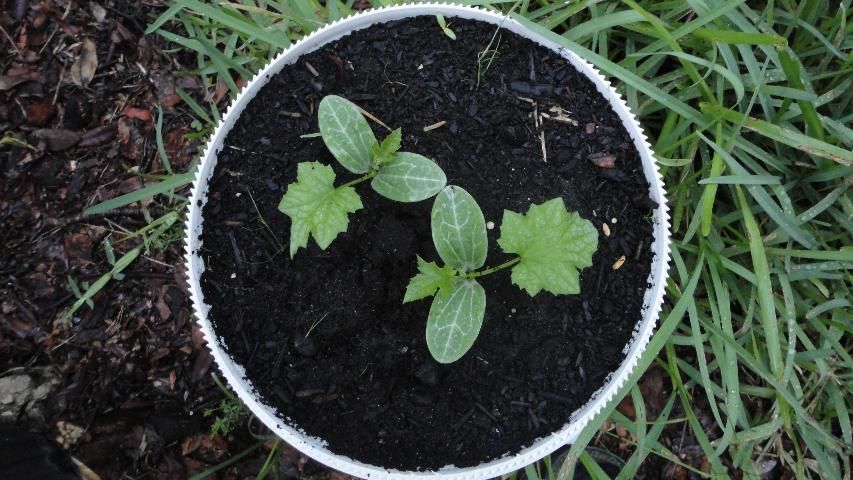
Credit: Guodong Liu, UF/IFAS
The mature luffa leaves have petioles 1 to 3 inches in length. The leaves have 3 to 7 lobes depending on soil fertility. Lamina shape is ovate or broadly ovate. Fully developed laminae are 3 to 6 inches in length and 2 to 5 inches in width, with 3 to 7 broad, rounded, or obtuse lobes (Figure 8). Some varieties are hispid-covered on either the back or both sides of the leaf.

Credit: Guodong Liu, UF/IFAS
Luffa inflorescences are monoecious: males (Figure 9) have elongate racemes with 10 to 16 flowers, and females (Figure 10) have a solitary flower. Both male and female flowers are yellow or orange and 2 to 3 inches in diameter. The pollinated flowers develop cylindrical fruit (Figures 1 and 2), and only young, immature fruits, which require the hot growing season of about two to three months, can be harvested for consumption as a vegetable. Luffa seeds are elliptic: a quarter to three eighths of an inch in length, one eighth to a quarter inch in width, and one sixteenth of an inch in thickness. Seeds are smooth or slightly rugose. Immature seeds are white in color, whereas mature seeds are dark brown or black (Figure 4). One mature luffa fruit contains 30 or more seeds (Partap et al. 2012).
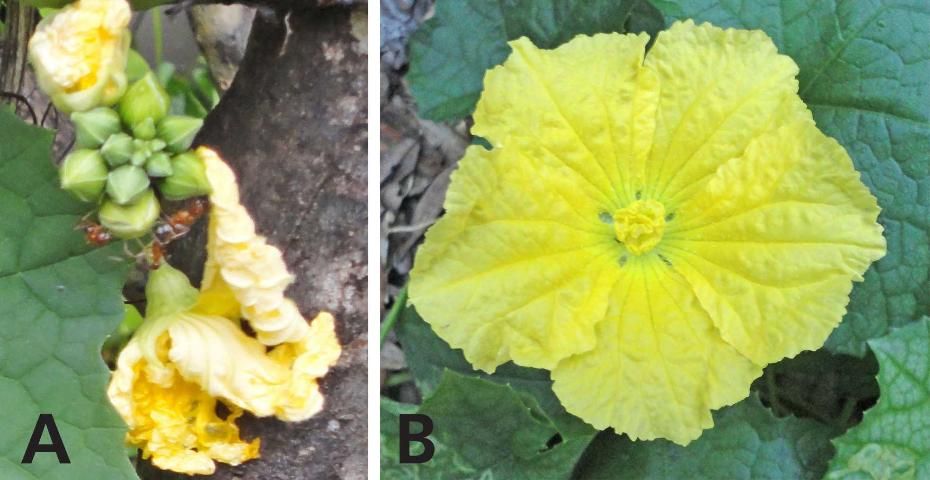
Credit: Guodong Liu, UF/IFAS

Credit: Guodong Liu, UF/IFAS
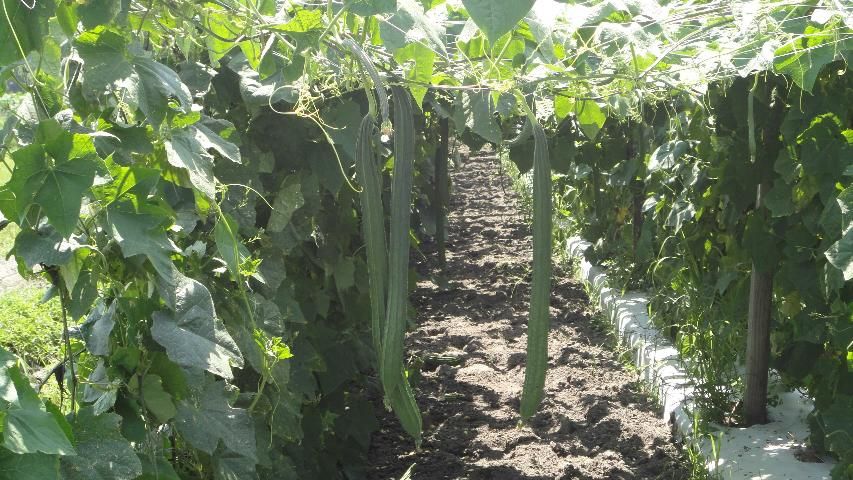
Credit: Guodong Liu, UF/IFAS
UF/IFAS is developing recommendations for fertilizer application rates. Before rates are established, growers can follow UF/IFAS recommendations for cucumber production (Liu et al. 2022): target soil pH of 6.0 to 6.5; nitrogen supplementation of 150 lbs/acre; both P2O5 and K2O supplementation of 100–120 lbs/acre for low and 80 lbs/acre for medium nutrient concentrations based on soil testing. Plastic mulch is commonly used in Florida but must be punctured to create holes large enough to avoid touching the seedlings. In northeast Florida, soil is rich in phosphorus. Growers should use liquid fertilizers of either 8-0-8 or 10-0-10 for fertigation through drip irrigation.
Leafminer is a common insect pest targeting luffa (Figure 12). If an infestation is severe, contact your local UF/IFAS Extension agents or see Vegetable Leafminer, Liriomyza sativae Blanchard (Insecta: Diptera: Agromyzidae) https://edis.ifas.ufl.edu/in507 (Capinera 2020).
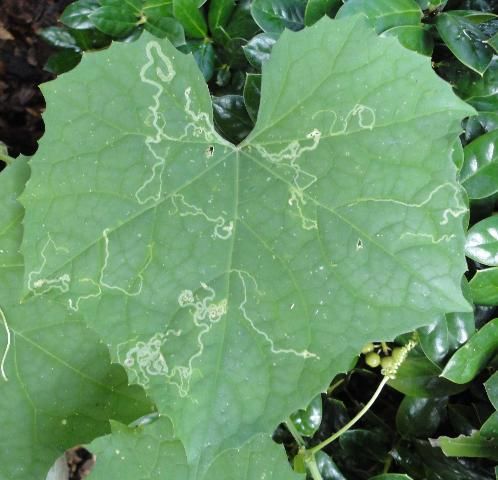
Credit: Guodong Liu, UF/IFAS
Fruit rot, a common disease, can lead to losses if fruits are grown near the ground. If luffa fruit is not harvested before maturation, the fruit will become fibrous, resulting in a tough texture and bitter taste. Seeds from mature fruit can be collected and laid onto paper to dry. Once dry, the seeds can be kept in mason jars with tight-fitting lids or glass canisters with gasketed lids and stored in cool, dark, and dry conditions for the next cropping.
Luffa Uses
The use of the luffa fruit is dependent on its growth stage. The immature fruit is a nutritious vegetable and is popular in Asian cuisine. Additionally, another species of luffa, called ball luffa (Luffa operculata (L.) Cogn.), is used as a fibrous scrubbing sponge (Figure 13) for household cleaning. Its common names include sponge cucumber and wild loofa (Filipowicz and Schaefer 2014). Ball luffa is rarely, if ever, eaten. Moreover, luffa sponges are recyclable and biodegradable and can be applied as an eco-friendly material in packaging, water absorption, and water waste treatment (Shen et al. 2012).

Credit: Guodong Liu, UF/IFAS
When harvested, immature luffa fruit can be cooked and eaten like cucumber or squash and is highly nutritious. Immature fruit can also be eaten raw. Abitogun and Ashogbon (2010) studied raw and defatted luffa cylinders to determine the proximate mineral and energy composition, including crude proteins, moisture, fat content, ash content, crude fiber, and carbohydrates (Table 1). A high crude protein content was found in defatted luffa, confirming that luffa could be used to supply nutrients to other farm products (Abitogun and Ashogbon 2010). However, while less bitter leaves and roots can be consumed as food, the tough fibrous vines are not edible. Mature luffas look brown and can be harvested for seeds for next growing season. The sponges can be used for cleaning.
Luffa fruit are similar in taste to zucchinis and cucumbers, with some varieties exhibiting a sweeter taste than others. In Asian cuisine, edible luffa is usually cooked with olive oil and seasoned with soy sauce and cayenne pepper. A simple luffa recipe involves boiling the sliced luffa fruit as shown below. First, peel luffa fruit with a peeler (Figure 14a). Then, slice the fruit (Figure 14b). Next, boil the sliced fruit (Figure 14c) with approximately 2 fluid ounces of water per pound of sliced fruit. After boiling for 2 to 3 minutes, stir the salt into the boiling mixture. Now the luffa is ready to be drained and served (Figure 14d). It can also be served as a luffa soup without draining.

Credit: Guodong Liu, UF/IFAS
Luffa fruit is rich in phosphorus, potassium, vitamin A, and vitamin C (Table 1), with benefit to the immune system and general health. Luffa has diuretic and purgative effects. It helps alleviate asthma and skin disease (Dhiman 2012). Luffa also contains triterpenoid saponins such as lucyosides and flavonoids such as apigenin. The seed extracts contain polypeptides, e.g., luffins. These physiologically active compounds have pharmacological effects such as anti-inflammation, anti-fungal, anti-allergy, anti-asthma, and anti-tussive (Partap et al. 2012).
Currently, luffa is primarily consumed by Asian populations, and consumption in Asian restaurants and homes is predominant in New York and other large cities with sizable Asian populations. A key economic venture for Florida growers would be to partner with distributors in these geographical locations. As cleansing sponges processed mature luffa has more widespread value for bathroom and kitchen cleaning purposes and can be sold in gift shops. In 2008, it was reported that luffa sponges can sell at a range of 1–5 dollars per unit and can bring up to 40 cents at wholesale. A grower can expect outputs more than 20,000 sponges per acre, reaching sizable profits (Jeanine 2008). In Florida, two production seasons are usual: from early March to late July and from late July to late November.
Summary
Luffa is becoming an increasingly profitable vegetable crop in Florida. This fruit creates market and food diversity and also enhances the competitiveness of Florida's vegetable industry. Florida's unique geography and climate present obvious advantages in luffa production. This geographical advantage is particularly apparent in the fall season, during which other states cannot grow this crop profitably due to limitations of climate conditions. Florida growers can grow this crop well into the mediate cold winter season, providing a unique economic opportunity.
References and Further Reading
Abitogun A. S and A. O. Ashogbon. 2010. "Nutritional Assessment and Chemical Composition of Raw and Defatted Luffa cylindrica Seed Flour." Ethnobotanical Leaflets 14: 225–35.
Capinera, J. L. 2020. Vegetable Leafminer, Liriomyza sativae Blanchard (Insecta: Diptera: Agromyzidae). EENY255. Gainesville: University of Florida Institute of Food and Agricultural Sciences. https://edis.ifas.ufl.edu/in507. Accessed on January 18, 2023.
Davis J. M. 1994. "Luffa Sponge Gourd Production Practices for Temperate Climates." HortScience 29(4): 263–266.
Davis, J. 2008. Commercial Luffa Sponge Gourd Production. NC State University & A&T State University Cooperative Extension. http://content.ces.ncsu.edu/commercial-luffa-sponge-gourd-production. Accessed on September 18, 2019.
Dhiman, K. A, Gupta, D. K. Sharma, N. S. Gill, and A. Goyal. 2012. "A Review on the Medicinally Important Plants of the Family Cucurbitaceae." Asian Journal of Clinical Nutrition 4(1): 16–26.
Egel, D. S., R. Weinzierl, P. O'Malley, R. Cloyd, B. Hutchinson, J. Pinero, and C. Welty. 2016. "Asian Vegetables." Midwest Vegetable Production Guide for Commercial Growers. Purdue University.
Filipowicz, N. H. and H. Schaefer. 2014. "Revisiting Luffa (Cucurbitaceae) 25 Years After C. Heiser: Species Boundaries and Application of Names Tested with Plastid and Nuclear DNA Sequences." Systematic Botany 39(1): 205–215.
Shen, J., Y.M. Xie, X.D.Huang, S. W. Zhou, and Ruan D. 2012. "Mechanical properties of luffa sponge." Journal of the Mechanical Behavior of Biomedical Materials 15:141–152. https://www.sciencedirect.com/science/article/pii/S1751616112001993. Accessed on February 4, 2023.
Lee, S. and J. G. Yoo. 2006. "Method for preparing transformed luffa cylindrica Roem." World Intellectual Property Organization.
Liu, G. D., E. H. Simonne, K. T. Morgan, G. J. Hochmuth, M. Ozores-Hampton, and S. Agehara. 2022. Chapter 2. Fertilizer Management for Vegetable Production in Florida. CV296. Gainesville: University of Florida Institute of Food and Agricultural Sciences. https://edis.ifas.ufl.edu/cv296. Accessed on January 18, 2023.
Oboh, I. O., and E. O. Aluyor. 2009. "Luffa cylindrica - an emerging cash crop." African Journal of Agricultural Research 4 (8): 684–688.
Partap, S. A. Kumar, N. K. Sharma, and K. K. Jha. 2012. "Luffa Cylindrica: An important medicinal plant." J. Nat. Prod. Plant Resour. 2 (1):127–134.
Stephens, J. M. 2018. Gourd, Luffa—Luffa cylindrica (L.) Roem., Luffa aegyptica Mill., and Luffa acutangula (L.) Roxb. HS604. Gainesville: University of Florida Institute of Food and Agricultural Sciences. https://edis.ifas.ufl.edu/mv071. Accessed January 18, 2023.
USDA Natural Resources Conservation Service. "Luffa acutangula (L.) Roxb." http://plants.usda.gov/core/profile?symbol=LUAC2. Accessed January 18, 2023.
USDA Natural Resources Conservation Service. "Luffa acutangula (L.) Roxb." Available online at: http://plants.usda.gov/core/profile?symbol=LUAC2. Accessed January 18, 2023.
Zong, R. J., C. Marita, and L. M. Leonard. 1993. "Angled luffa, bitter melon, fuzzy melon, yard-long bean-postharvest handling of Asian specialty vegetables under study." California Agriculture 47(2):27–29.